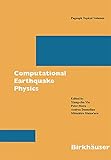Computational Earthquake Physics: Simulations, Analysis and Infrastructure, Part I [electronic resource] / edited by Xiang-chu Yin, Peter Mora, Andrea Donnellan, Mitsuhiro Matsu’ura.
Series: Pageoph Topical VolumesPublisher: Basel : Birkhäuser Basel, 2006Description: 310 p. online resourceContent type:- text
- computer
- online resource
- 9783764379926
- 550 23
- GB3-5030
- QE1-996.5
 eBooks
eBooks
Computational Earthquake Physics PART I: Introduction -- Fracture of a Liquefied Crack and the Physics of Rayleigh Waves -- Experimental Evidence of Critical Sensitivity in Catastrophe -- Implementation of Particle-scale Rotation in the 3-D Lattice Solid Model -- Numerical and Experimental Study on Progressive Failure of Marble -- 3-D Simulation of Tectonic Loading at Convergent Plate Boundary Zones: Internal Stress Fields in Northeast Japan -- Virtual California: Fault Model, Frictional Parameters, Applications -- Catastrophic Rupture Induced Damage Coalescence in Heterogeneous Brittle Media -- Differences Between Mode I and Mode II Crack Propagation -- Dynamic Rupture in a 3-D Particle-based Simulation of a Rough Planar Fault -- Numerical Simulation of the Effect of a DC Electric Field on Seismic Wave Propagation with the Pseudospectral Time Domain Method -- Quartz Rheology and Short-time-scale Crustal Instabilities -- Recurrence Interval Statistics of Cellular Automaton Seismicity Models -- Parallel 3-D Simulation of a Fault Gouge Using the Lattice Solid Model -- Benioff Strain Release Before Earthquakes in China: Accelerating or Not? -- Improvement in the Fault Boundary Conditions for a Staggered Grid Finite-difference Method -- The Displacement and Strain Field of Three-dimensional Rheologic Model of Earthquake Preparation -- Deformations in Transform Faults with Rotating Crustal Blocks -- Elasticity, Yielding and Episodicity in Simple Models of Mantle Convection.
Exciting developments in earthquake science have benefited from new observations, improved computational technologies, and improved modeling capabilities. Designing realistic supercomputer simulation models for the complete earthquake generation process is a grand scientific challenge due to the complexity of phenomena and range of scales involved from microscopic to global. The book is divided into two parts: The present volume - Part I - focuses on microscopic simulation, scaling physics, dynamic rapture and wave propagation, earthquake generation, cycle and seismic pattern. Topics covered range from numerical developments, rupture and gouge studies of the particle model, Liquefied Cracks and Rayleigh Wave Physics, studies of catastrophic failure and critical sensitivity, numerical and theoretical studies of crack propagation, developments in finite difference methods for modeling faults, long time scale simulation of interacting fault systems, modeling of crustal deformation, through to mantle convection.


